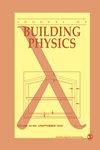Hygrothermal performance of highly insulated external walls subjected to indoor air exfiltration
IF 1.4
4区 工程技术
Q3 CONSTRUCTION & BUILDING TECHNOLOGY
引用次数: 0
Abstract
The study comprises three laboratory tests in which typical Finnish highly insulated (HI) walls were exposed to concentrated leakages of indoor air under steady outdoor temperatures of 1–5°C. Airflows with a relative humidity of 50% and at rates of 1–3 L/min were directed close to the wooden frames inside the walls. The thermal resistance ratios between the exterior sheathing(s) and the whole wall (Γ) were 20%–22% and 1%–10% for the HI and baseline (BL) walls. The HI walls that presented Γ values of at least 20% were observed to be resistant to air exfiltration, and their durability was not affected by the addition of a gypsum sheathing outside the wooden frame or a more permeable vapor retarder. This is related to the negative linear correlation that exists between the moisture accumulation rate in wood-based material and the dew point depression (DPD) value. The developed approach, called the DPD method, shows that a significant degree of moisture accumulation does not occur even for DPD values of as low as −2°C if the exterior sheathing is vapor permeable. The airflow does not penetrate into the rigid mineral wool sheathing, which helps to avoid interstitial condensation. Regardless of thermal transmittance, the HI and BL walls with maximum Γ values of 1% were exposed to a high relative humidity and even interstitial condensation because the DPD values were often below −2°C. For these walls, the mold index analysis and visual observations confirmed the local risk for mold growth on the opposite side of the leakage point. In practice, long-term mold growth may be limited if the seasonal periods during which the outdoor temperature is 1–5°C last for a maximum of about 1 month every year.受室内空气泄漏影响的高绝热外墙的湿热性能
该研究包括三个实验室测试,在1-5°C的稳定室外温度下,将典型的芬兰高度绝缘(HI)墙壁暴露在室内空气的集中泄漏中。相对湿度为50%,速度为1-3升/分钟的气流被引导到墙内的木制框架附近。外护套与全墙的热阻比(Γ)分别为20% ~ 22%和1% ~ 10%。研究人员观察到,Γ值至少为20%的HI墙能够抵抗空气泄漏,并且其耐久性不受在木框架外添加石膏护套或渗透性更强的缓蒸气剂的影响。这与木基材料中水分积累速率与露点降值之间存在负线性相关关系有关。所开发的方法,称为DPD方法,表明即使DPD值低至- 2°C,如果外部护套是透气性的,也不会发生显著程度的水分积累。气流不会渗透到坚硬的矿棉护套中,这有助于避免间隙冷凝。无论热透射率如何,由于DPD值通常低于- 2°C,因此Γ值最大为1%的HI和BL壁暴露于高相对湿度甚至间隙冷凝中。对于这些墙壁,霉菌指数分析和目视观察证实了泄漏点对面霉菌生长的局部风险。在实践中,如果室外温度为1 - 5°C的季节期间每年最多持续约1个月,则可能会限制霉菌的长期生长。
本文章由计算机程序翻译,如有差异,请以英文原文为准。
求助全文
约1分钟内获得全文
求助全文
来源期刊

Journal of Building Physics
工程技术-结构与建筑技术
CiteScore
5.10
自引率
15.00%
发文量
10
审稿时长
5.3 months
期刊介绍:
Journal of Building Physics (J. Bldg. Phys) is an international, peer-reviewed journal that publishes a high quality research and state of the art “integrated” papers to promote scientifically thorough advancement of all the areas of non-structural performance of a building and particularly in heat, air, moisture transfer.
 求助内容:
求助内容: 应助结果提醒方式:
应助结果提醒方式:


